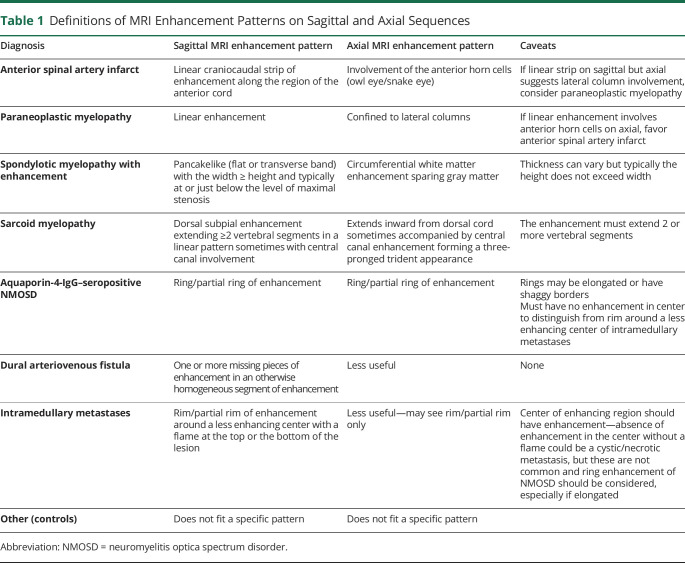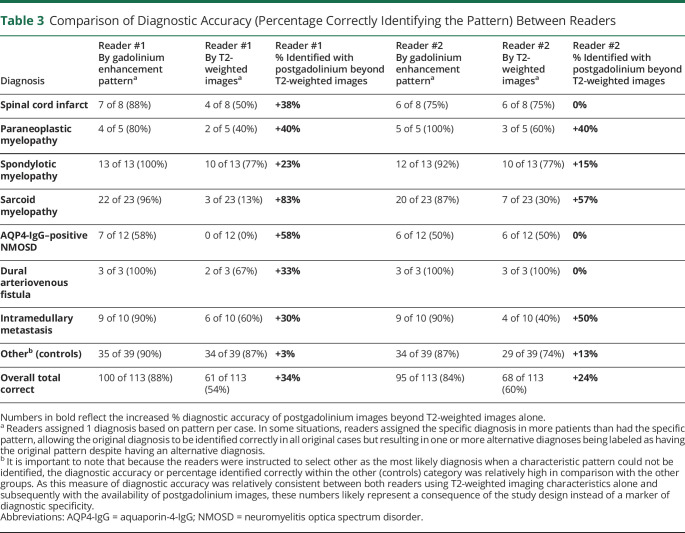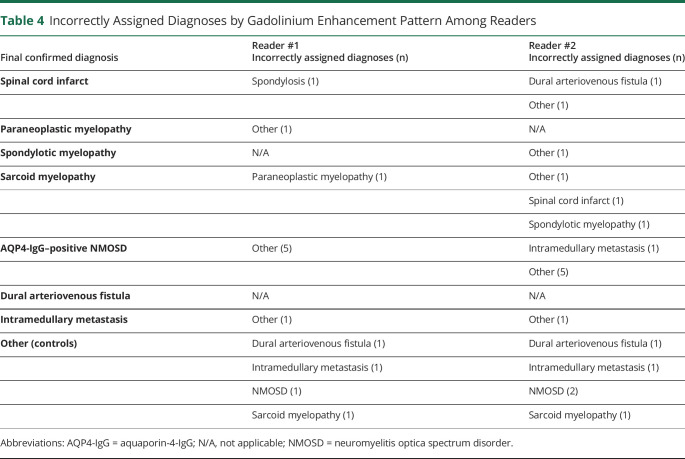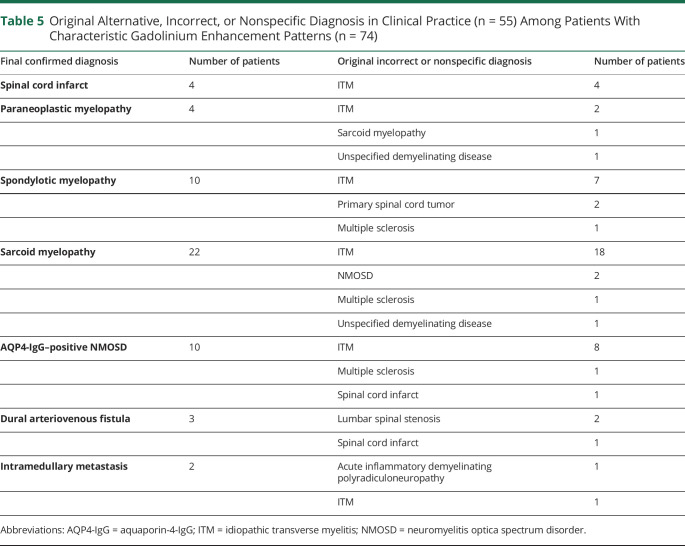Abstract
Objective
To determine whether MRI gadolinium enhancement patterns in myelopathies with longitudinally extensive T2 lesions can be reliably distinguished and assist in diagnosis.
Methods
We retrospectively identified 74 Mayo Clinic patients (January 1, 1996–December 31, 2019) fulfilling the following criteria: (1) clinical myelopathy; (2) MRI spine available; (3) longitudinally extensive T2 hyperintensity (≥3 vertebral segments); and (4) characteristic gadolinium enhancement pattern associated with a specific myelopathy etiology. Thirty-nine cases with alternative myelopathy etiologies, without previously described enhancement patterns, were included as controls. Two independent readers, educated on enhancement patterns, reviewed T2-weighted and postgadolinium T1-weighted images and selected the diagnosis based on this knowledge. These were compared with the true diagnoses, and agreement was measured with Kappa coefficient.
Results
Among all cases and controls (n = 113), there was excellent agreement for diagnosis using postgadolinium images (kappa, 0.76) but poor agreement with T2-weighted characteristics alone (kappa, 0.25). A correct diagnosis was more likely when assessing postgadolinium image characteristics than with T2-weighted images alone (rater 1: 100/113 [88%] vs 61/113 [54%] correct, p < 0.0001; rater 2: 95/113 [84%] vs 68/113 [60%] correct, p < 0.0001). Of the 74 with characteristic enhancement patterns, 55 (74%) were assigned an alternative incorrect or nonspecific diagnosis when originally evaluated in clinical practice, 12 (16%) received immunotherapy for noninflammatory myelopathies, and 2 (3%) underwent unnecessary spinal cord biopsy.
Conclusions
Misdiagnosis of myelopathies is common. The gadolinium enhancement patterns characteristic of specific diagnoses can be identified with excellent agreement between raters educated on this topic. This study highlights the potential diagnostic utility of enhancement patterns in myelopathies with longitudinally extensive T2 lesions.
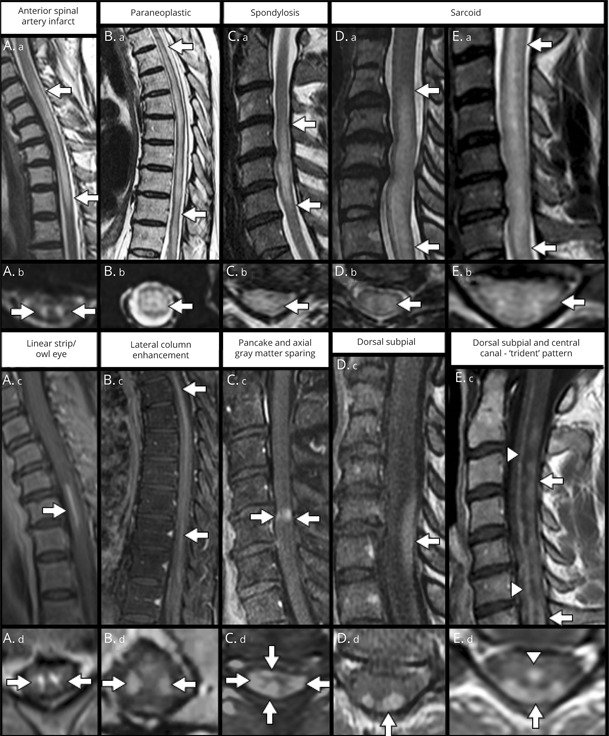
Rapidly identifying the etiology of myelopathy is crucial as severe neurologic deficits may ensue when diagnosis and disease-specific treatment are delayed. Prior studies have shown that myelopathy diagnosis can be challenging, and in practice, the term idiopathic transverse myelitis (ITM) is often proposed as a diagnosis inappropriately.1 In 1 study of patients referred with a presumptive diagnosis of ITM, only 54% had a confirmed inflammatory etiology.2 Previously, we reported that 70% of patients referred with a diagnosis of ITM were diagnosed with an alternative, more specific myelopathy diagnosis. Presumptive diagnosis of ITM may lead to premature termination of diagnostic evaluations and inappropriate treatment decisions that drastically affect patient outcomes.1
The pattern of gadolinium enhancement accompanying longitudinally extensive T2-hyperintensities can be a critical clue to diagnosis and guide further investigations to confirm the diagnosis. Several gadolinium enhancement patterns have been proposed to strongly suggest a specific etiology including: linear craniocaudal strip of enhancement in spinal cord infarction (SCI)3; tract-specific enhancement in paraneoplastic myelopathy4; pancakelike transverse band of enhancement in spondylotic myelopathy5; dorsal subpial enhancement6,7 and axial trident sign8 in sarcoid myelopathy; ring/partial ring enhancement in neuromyelitis optica spectrum disorders (NMOSDs)9; missing-piece sign in spinal dural arteriovenous fistula (DAVF)10; and rim or flame signs in intramedullary spinal cord metastases.11 Whether these can be reliably identified or distinguished has not yet been established. In this study, we tested whether such specific gadolinium enhancement patterns could be reliably distinguished and assist in determining the diagnosis of myelopathy beyond the T2-weighted images alone.
Methods
Standard Protocol Approvals, Registrations, and Patient Consents
All patients in our study consented to the use of their medical records for research purposes. The study was approved by the Institutional Review Board of Mayo Clinic, Rochester, MN (IRB 19-004180).
Patients
Patients for this study were retrospectively identified from prior Mayo Clinic–published studies analyzing these gadolinium enhancement patterns including spinal cord infarct (n = 8),3 paraneoplastic myelopathy (n = 3),4 spondylotic myelopathy (n = 8),5 sarcoid myelopathy (n = 14),6,8 aquaporin-4-IgG (AQP4-IgG)-positive NMOSD (n = 7),9 DAVF (n = 3),10 intramedullary metastasis (n = 10),11 and from our database of patients with nontraumatic myelopathy (n = 21) for a total of 74 patients over a time range of 1/1/1996 to 12/31/2019. For our gadolinium enhancement pattern group, we included these 74 patients fulfilling the following criteria: 1) clinical myelopathy; 2) spine MRI with and without gadolinium from the time of clinical presentation available for reanalysis; 3) longitudinally extensive T2 hyperintensity in the spinal cord defined as a parenchymal T2 hyperintensity extending 3 or more vertebral segments on sagittal sequences; and 4) a classic gadolinium enhancement pattern associated with a particular myelopathy etiology as described in prior publications (table 1). Images were reviewed by R.M. and E.P.F., and consensus was reached if a characteristic enhancement pattern was present and those deemed to have moderate- or poor-quality imaging that prevented a characteristic enhancement pattern being visible were excluded. Also, patients not fulfilling the definitions for each diagnosis below were excluded. Hyperintense T1 signal postgadolinium in all cases was true enhancement (i.e., not inherent precontrast T1 hyperintensity as can be seen with blood products for example). The Mayo Clinic electronic medical records of all patients including detailed history and examination findings, laboratory values, and imaging findings were independently reviewed by 2 investigators for study inclusion (R.M. and E.P.F.), and R.M. abstracted clinical data. The initial diagnoses assigned to patients in clinical practice after imaging was available were recorded as were final clinical diagnoses by criteria described below. In cases in which the initial diagnosis differed from the final diagnosis, additional details regarding medical treatments prescribed to patients and/or surgical procedures performed were also recorded.
Table 1.
Definitions of MRI Enhancement Patterns on Sagittal and Axial Sequences
Clinical Diagnosis Definitions in Patients With Enhancement Patterns
The final clinical diagnosis was defined for each disorder based on published criteria or based on the description from prior studies as follows: (1) SCI by its published diagnostic criteria3; (2) paraneoplastic myelopathy by clinical diagnosis and as an additional requirement an antibody strongly associated with cancer (>80% positive predictive value) or a concurrent cancer in accordance with its definition from a prior study4; (3) spondylotic myelopathy with enhancement by both clinical diagnosis and surgical decompression to have been performed as previously described5; (4) probable or definite neurosarcoidosis (pathologically confirmed systemically or of the nervous system) by the consensus diagnostic criteria12; (5) aquaporin-4-IgG–seropositive NMOSD by the international consensus diagnostic criteria13; (6) DAVF by identification of a fistula on spinal cord angiography14; and (7) intramedullary metastases by the clinical diagnosis and/or pathologic confirmation within the cord as previously described.11 Each of the included 74 patients with characteristic enhancement patterns may not necessarily have completed all the comprehensive diagnostic workup discussed above, but did at a minimum undergo the appropriate diagnostic testing (e.g., spinal cord angiography for DAVF) for confirmation of the final clinical diagnosis assigned.
Diagnoses in Controls
We selected 39 patients with other confirmed myelopathy diagnoses and a sagittal T2 longitudinally extensive hyperintense lesion (≥3 vertebral segments) with accompanying gadolinium enhancement from our myelopathy database of patients used in prior studies.5,15,16 The alternative confirmed diagnoses included primary spinal cord tumor, 30 (ependymoma, 13; primary intramedullary spinal cord lymphoma, 7; hemangioblastoma, 5; astrocytoma, 2; ganglioglioma, 1; primitive neuroectodermal tumor, 1; and glioma not otherwise specified, 1); MOG (myelin oligodendrocyte glycoprotein)-IgG–associated myelitis, 8; and spinal cavernous malformation, 1.
Study Design and Radiology Review
Two readers, a board-certified neurologist (A.S.L.C.) and neuroradiologist (T.J.P.) not previously involved in establishing any of the described enhancement patterns, were educated on the described gadolinium enhancement patterns summarized in table 1 and shown an example of each similar to those outlined in figures 1 and 2; the training set did not include cases used in the study set. Representative MRIs were reviewed directly on Quick Query Radiographs and Photographs Electronic Analysis and Display Station (QREADS) or Visage Picture Archiving and Communication System (PACS) neuroimaging programs. Sagittal T2-weighted, axial T2-weighted, postgadolinium sagittal T1-weighted, and postgadolinium axial T1-weighted imaging sequences were collected for blinded assessment; both studies from Mayo Clinic and from other institutions were included in the assessments.
Figure 1. T2-Weighted and Postgadolinium T1-Weighted MRI Patterns in Various Myelopathy Diagnoses (Part 1).
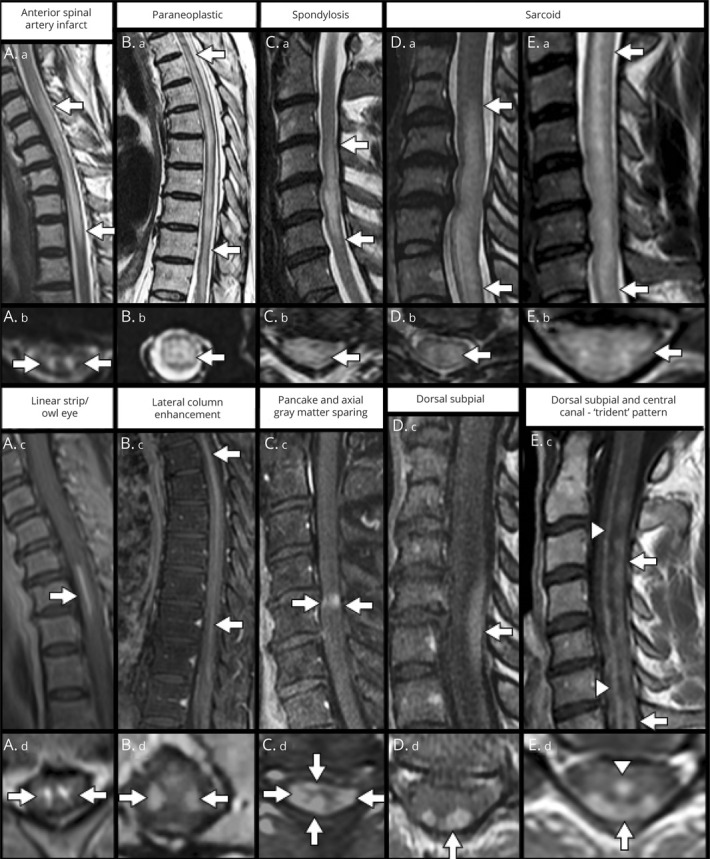
A T2 hyperintense lesion (arrows) on sagittal MRI (A.a) displaying anterior predominant gray matter involvement (arrows) on cross section (A.b) with a typical craniocaudal linear strip (arrow) of enhancement (A.c) and more defined owl eye enhancement pattern (A.d, arrows) seen in anterior spinal artery infarct. A T2 hyperintense lesion (arrows) on sagittal MRI (B.a) spanning the entire cross-sectional area (arrow) of the spinal cord (B.b) with linear enhancement (B.c, arrow) in a pattern following the lateral columns (B.d, arrows) seen in paraneoplastic myelopathy. A compressive myelopathy highlighting an area of T2 hyperintensity (C.a-C.b, arrows) with an associated transverse band of pancakelike enhancement (arrows) just below the maximal area of stenosis (C.c) with sparing of the axial gray matter (C.d, arrows) seen in spondylotic myelopathy. Longitudinally extensive T2 hyperintense lesions (D.a, D.b, E.a, E.b, arrows) with extensive dorsal subpial enhancement (arrows) alone (D.c, D.d) or in combination (E.c, E.d) with central canal enhancement (arrowheads) forming the shape of a trident (E.d) seen in patients with sarcoid myelopathy.
Figure 2. T2-Weighted and Postgadolinium T1-Weighted MRI Patterns in Various Myelopathy Diagnoses (Part 2).
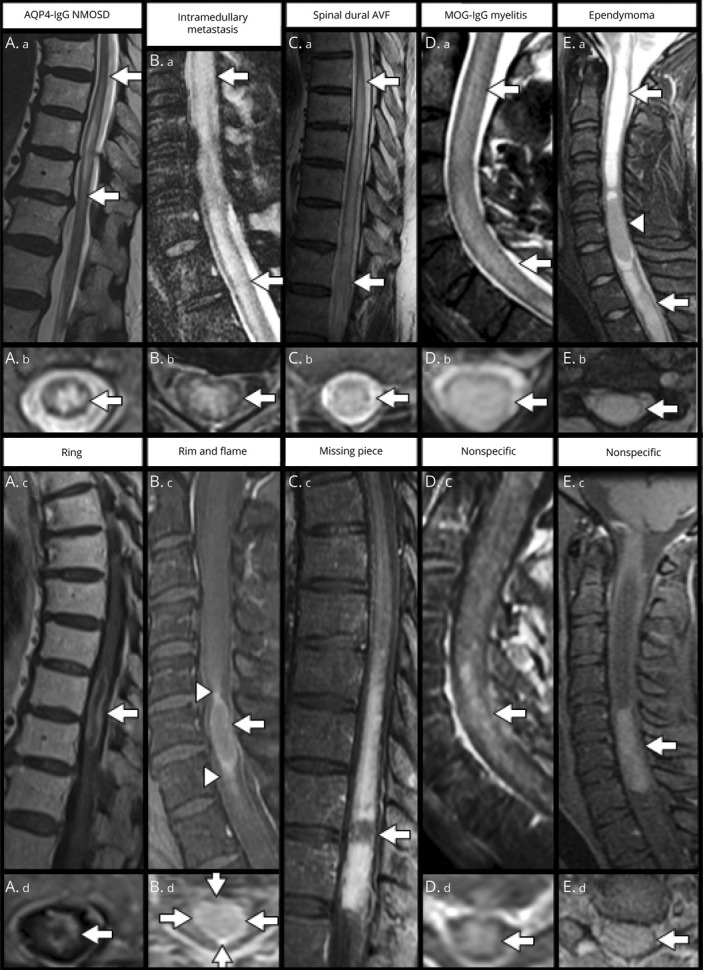
A longitudinally extensive T2 hyperintense transverse myelitis (A.a-A.b, arrows) with associated elongated ring/partial ring enhancement (A.c-A.d, arrows) seen in AQP4-IgG NMOSD. A longitudinally extensive T2 hyperintense lesion (B.a-B.b, arrows) with an associated rim (arrows) and flame (arrowheads) pattern of enhancement surrounding a less enhancing center (B.c-B.d) seen in spinal cord intramedullary metastasis. Diffuse T2 hyperintensity (C.a-C.b, arrows) with apparent flow voids predominantly along the dorsal cord surface (C.a) and a missing piece of enhancement (C.c, arrow) in spinal dural arteriovenous fistula. Nonspecific T2 hyperintensity (D.a-D.b, arrows) and faint nonspecific contrast enhancement (D.c-D.d, arrows) seen in a patient with MOG-IgG associated myelitis. A T2 hyperintense expansile lesion (arrows) with mass effect (arrowhead) (E.a-E.b) and no clear pattern of associated contrast enhancement (E.c-E.d, arrows) seen in a patient with spinal cord ependymoma. (A) reprinted with permission from Sechi E, Flanagan EP. Autoimmune Demyelinating Syndromes: NMOSD and Anti-MOG Disease, Neuroimmunology, Springer, April 2021. (C) modified with permission from Zalewski NL, Rabinstein AA, Brinjikji W, et al. Unique Gadolinium Enhancement Pattern in Spinal Dural Arteriovenous Fistulas. JAMA Neurol 2018;75:1542-1545.
Blinded to clinical details including diagnosis and imaging sequences other than MRI of the spine, both readers initially reviewed the T2-weighted sequences for each case and independently selected the most likely diagnosis from those available in table 1 based on T2 abnormalities (e.g., adjacent spinal cord flow voids in DAVF). Subsequently, they independently reviewed the postgadolinium T1-weighted sequences and selected the most likely diagnosis from the same list. If a characteristic pattern suggestive of a specific myelopathy diagnosis could not be identified, the readers were instructed to select other as the most likely diagnosis. The selected diagnoses were compared with the established diagnoses.
Statistical Analysis
Summary statistics were reported as percentage correct. Interreader agreement was assessed using the Cohen kappa (κ) test, and the McNemar test was used to compare the diagnostic accuracy (percentage correct) of each reader with the availability of T2-weighted imaging sequences alone vs with the additional availability of postgadolinium T1-weighted imaging sequences (JMP software 14.0; SAS Institute, Cary, NC). Terminology suggested by Fleiss17 was used to associate descriptive terms to numerical values of the kappa statistic. We defined kappa (κ) values of: <0.4 as poor agreement; 0.4–0.75 as fair to good agreement; and >0.75 as excellent agreement.
Data Availability
Anonymized data used for this study are available from the corresponding authors on reasonable request.
Results
The demographics and distribution of the 74 patients with confirmed gadolinium enhancement patterns are summarized in table 2. Among all cases and controls (n = 113), there was excellent agreement 94/113 (83%) between raters using postgadolinium images (kappa, 0.76) but poor agreement 71/113 (63%) using the T2-weighted pattern alone (kappa, 0.25). When considering T2 images alone, both reviewers made incorrect diagnoses 24% (27/113) of the time, whereas when considering postgadolinium images, this only occurred 5% (6/113) of the time (p = <0.001). Representative neuroimaging examples highlighting the utility of the gadolinium enhancement pattern for each myelopathy diagnosis, including 2 examples of control cases (MOG-IgG–associated myelitis and ependymoma), are illustrated in figures 1 and 2.
Table 2.
Demographics and Distribution of Specific Myelopathy Diagnoses (n = 74)

Each rater assigned the correct diagnosis based on the gadolinium enhancement pattern more frequently than based on T2 image characteristics alone (rater 1, 100/113 [88%] vs 61/113 [54%] correct, p < 0.0001; rater 2, 95/113 [84%] vs 68/113 [60%] correct, p < 0.0001). Accuracy of diagnosis by gadolinium enhancement pattern and T2-weighted images for each myelopathy diagnosis by each of the 2 readers is summarized in table 3. Of note, sarcoid myelopathy and spondylotic myelopathy were identified with very high accuracy using postgadolinium images by each of the 2 raters (rater 1, 22/23 [96%] accurate for sarcoid myelopathy, 13/13 [100%] accurate for spondylotic myelopathy; rater 2, 20/23 [87%] accurate for sarcoid myelopathy, 12/13 [92%] accurate for spondylotic myelopathy).
Table 3.
Comparison of Diagnostic Accuracy (Percentage Correctly Identifying the Pattern) Between Readers
Among the 13 cases incorrectly identified by rater 1 using postgadolinium images, aquaporin-4-IgG–seropositive NMOSD was the least reliably identified in this study with 5 cases misidentified as other. Similarly with rater 2, of the 18 cases incorrectly identified using postgadolinium images, NMOSD again was the least reliably identified with 5 cases misidentified as other and 1 misidentified as intramedullary metastasis. Table 4 summarizes all the incorrectly assigned diagnoses by each of the 2 readers after reviewing postgadolinium images.
Table 4.
Incorrectly Assigned Diagnoses by Gadolinium Enhancement Pattern Among Readers
Of the 74 patients with characteristic gadolinium enhancement patterns, 55 (74%) were assigned an alternate, incorrect, or nonspecific diagnosis when originally evaluated in clinical practice before having their final diagnosis confirmed (table 5) despite the availability of postgadolinium sequences at that time. Twelve patients (16%) had received immunotherapy for noninflammatory myelopathies including IV corticosteroids (11), plasma exchange (3), and IV immune globulin (1). Two patients (3%) with spondylotic myelopathy underwent spinal cord biopsy revealing nonspecific inflammatory changes.
Table 5.
Original Alternative, Incorrect, or Nonspecific Diagnosis in Clinical Practice (n = 55) Among Patients With Characteristic Gadolinium Enhancement Patterns (n = 74)
Discussion
This study showed that gadolinium enhancement patterns can be identified with excellent agreement between 2 raters, increasing the diagnostic accuracy beyond the corresponding T2-weighted imaging sequences alone. Although our study is limited by the highly selected group of patients we included, our findings suggest that improved knowledge on gadolinium enhancement patterns may help reduce misdiagnosis of myelopathies with longitudinally extensive T2 lesions.
This study highlights the importance of obtaining post gadolinium images in patients with myelopathy accompanied by a longitudinally extensive T2 hyperintense lesion. Following education, these characteristic gadolinium enhancement patterns associated with specific myelopathies were readily and reliably identified by a neurologist and neuroradiologist. This is important because 74% of patients in this study were misdiagnosed initially, and in our experience, the gadolinium enhancement pattern is particularly useful in guiding the clinician toward the correct diagnosis. The risks of misdiagnosis in myelopathy are not trivial. For example, treating a spinal cord infarct with IV immune globulin, which is prothrombotic, or with plasma exchange, which can result in hypotension, could extend the infarct.3 Furthermore, treatment with corticosteroids in patients with DAVF has the potential for irreversible neurologic impairment from increased venous hypertension.18 Spondylotic myelopathy with enhancement is misdiagnosed in up to 70% of cases as neoplastic or inflammatory, subjecting patients to risk of morbidity from potential spinal cord biopsy or long-term immunosuppression; furthermore, delay in surgical decompression risks accumulation of irreversible disability.5 Recognition of tract-specific gadolinium enhancement in paraneoplastic myelopathy facilitates decisions to search for an otherwise occult malignancy responsible for the neurologic syndrome that often precedes cancer detection; paraneoplastic antibodies also assist but are not always detected.4 Recognition of the enhancement pattern may direct investigations to a specific diagnosis rather than a wider range of investigations and may thereby be a cost reduction strategy. Accurate diagnosis may reduce the prescription of costly ineffective medications where they are not appropriate (e.g., rituximab for spinal cord infarct).
Evaluation of neuroimaging alone is insufficient for diagnosis, although integrating neuroimaging with clinical and laboratory features is particularly powerful. The time to nadir is particularly important in myelopathy evaluation, and the presence of a hyperacute myelopathy along with the linear craniocaudal strip/owl eye enhancement pattern can help increase the confidence for a spinal cord infarct. Progression of the myelopathy beyond 21 days argues against ITM as the cause and should raise suspicion for an alternative cause. In this situation, identification of one of the enhancement patterns can be very useful in suggesting the diagnosis. Laboratory studies such as serum antibody biomarkers (e.g., AQP4-IgG and MOG-IgG) and CSF analysis provide powerful clues in evaluation of longitudinally extensive T2 hyperintense cord lesions and should be used in conjunction with the gadolinium enhancement pattern. However, sometimes, the enhancement pattern can be more specific than the serology.19
In this study, we assessed multiple enhancement patterns occurring at varying frequencies. Some patterns were more reliably detected than others. The dorsal subpial (figure 1D. c) and axial trident (figure 1E. d) enhancement patterns of sarcoid myelopathy and pancakelike transverse band of enhancement on sagittal sequences (figure 1C. c) with sparing of axial gray matter (figure 1C. d) of spondylotic myelopathy are particularly high-yield patterns for clinicians to recognize. These were very reliably identified in this study, distinguished from other myelopathy etiologies very well in prior studies,5,6 and are frequently encountered in our clinics. Ring/partial ring enhancement in NMOSD was less reliably detected and was noted in some controls (e.g., neoplasms) suggesting overlap may occur.
Our study design combining small numbers of multiple myelopathic diagnoses with hallmark enhancement patterns precluded a reliable analysis of the specificity of each enhancement pattern. However, sensitivity and specificity of several of these patterns have been reported in other studies. The rim-and-flame sign each individually had a specificity of 97%, and when both were present concurrently, the specificity was 100% vs primary spinal cord tumors.11 The pancakelike transverse band pattern of enhancement in spondylotic myelopathy was not found among 136 patients with alternative myelopathies.5 Ring/partial ring enhancement was found in AQP4-IgG–positive NMOSD myelitis and MS myelitis at similar frequency but not found among 66 alternative myelopathy diagnoses.9 Linear dorsal subpial enhancement was significantly more common in sarcoid myelopathy than in AQP4-IgG–positive NMOSD myelitis.6 The missing-piece sign in spinal DAVF was not found among 144 patients with alternative myelopathies.10 The tract-specific enhancement of paraneoplastic myelopathy, trident enhancement pattern of sarcoid myelopathy, and linear craniocaudal strip of enhancement in spinal cord infarct have been reported or illustrated independently in other publications from other investigators, although the frequency among control myelopathies has not been as well studied.20–22 Although the T2 patterns were overall less useful in determining the cause (figures 1 and 2), they remain useful for some etiologies (table 3), such as DAVF, where the presence of flow voids dorsal to the cord accompanying a thoracic longitudinally extensive T2-signal abnormality is very suggestive (figure 2C. a), SCI in which owl/snake eye T2 appearance can assist (diffusion-weighted imaging is also useful in this scenario), and spondylotic myelopathy where the degree of narrowing and spondylotic changes on T2-weighted sequences can be useful. However, MRI patterns detectable on T2-weighted and postgadolinium T1-weighted sequences are not always present simultaneously, and patients with specific gadolinium enhancement patterns often do not have accompanying specific abnormalities on T2-weighted images. The enhancement patterns should be considered a helpful guide toward diagnosis rather than pathognomonic and should not replace clinical judgment.
Our study focused on longitudinally extensive T2 hyperintense lesions with enhancement as this is when the pattern is most useful, although some of the described patterns may still be useful when accompanied by lesions spanning less than 3 vertebral segments. Also, imaging timing could not be standardized in this retrospective study and can affect the presence or absence of a T2 lesion and its length.3,23–26 Other gadolinium enhancement patterns (e.g., ventral subpial enhancement in a braid-like pattern in sarcoid myelopathy)21,27 or unenhanced T2 patterns (e.g., bright spotty lesions with AQP4-IgG–seropositive NMOSD, cap sign in ependymoma)28,29 have also been associated with myelopathies, but assessment of such cases was not undertaken in this study.
This study has a number of limitations. The retrospective design is a limitation, but prospective studies of all myelopathies would be difficult given that some of these diagnoses are rare and were collected over several decades. We selected cases based on their myelopathy enhancement pattern, and thus, it is not surprising that the postgadolinium sequences proved more useful than the T2 images. It should not be assumed that postgadolinium images are universally more useful, but rather, when present, the specific patterns we report may significantly improve the diagnostic accuracy beyond T2-weighted images alone. Raters assessed T2-weighted images first and therefore had more information available when reviewing T1-weighted postgadolinium images, but this closely resembles the order these are assessed in clinical practice. Our cases were highly selected, with a focus on those with high-quality imaging; it is uncertain whether the results would be equivalent were cases with lower quality imaging included. Nonetheless, 74% of patients in this study were initially assigned alternative nonspecific or incorrect diagnoses despite high-quality images, suggesting recognition of these gadolinium enhancement patterns is suboptimal.
In summary, this study suggests that certain well-described gadolinium enhancement patterns that assist with diagnosis of myelopathies associated with longitudinally extensive T2 lesions can be reliably identified by 2 blinded raters educated on the topic. Prospective studies are needed as are further studies of the sensitivity and specificity of the patterns we described. Clinicians should learn to recognize gadolinium enhancement patterns in myelopathies with longitudinally extensive T2 hyperintense lesions, which will focus investigations, decrease cost, and reduce morbidity by allowing earlier diagnosis and disease-specific treatment.
Acknowledgment
The authors thank Dr. Sarosh Irani, MA (Oxon), DPhil, MRCP (Nuffield Department of Clinical Neurosciences, University of Oxford, Oxford OX3 9DU, United Kingdom) for his assistance with the concept and design of this study.
Appendix. Authors

Study Funding
No targeted funding reported.
Disclosure
Dr. Mustafa, Dr. Passe, and Dr. Lopez-Chiriboga report no disclosures. Dr. Weinshenker receives royalties from RSR Ltd, Oxford University, Hospices Civil de Lyon, and MVZ Labor PD Dr. Volkmann und Kollegen GbR for a patent of NMO-IgG as a diagnostic test for neuromyelitis optica spectrum disorders, served on adjudication committee for clinical trials in neuromyelitis optica spectrum disorders being conducted by MedImmune and Alexion, and consulted for Chugai/Roche/Genentech and Mitsubishi-Tanabe regarding a clinical trial for neuromyelitis optica spectrum disorders. Dr. Krecke, Dr. Zalewski, Dr. Diehn, and Dr. Sechi report no disclosures. Dr. Mandrekar and Dr. Kaufmann report no disclosures relevant to this study. Dr. Morris reports no disclosures. Dr. Pittock reports grants, personal fees, and nonfinancial support from Alexion Pharmaceuticals, Inc.; grants from Grifols and Autoimmune Encephalitis Alliance; and grants, personal fees, nonfinancial support, and other from MedImmune, Inc.; Dr. Pittock has a patent # 9,891,219 (Application #12–573942) “Methods for treating neuromyelitis optica (NMO) by administration of eculizumab to an individual that is aquaporin-4 (AQP4)-IgG autoantibody positive”. Dr Pittock also has patents pending for the following IgGs as biomarkers of autoimmune neurologic disorders (septin-5, Kelch-like protein 11, GFAP, PDE10A, and MAP1B). Dr. Toledano reports no disclosures. Dr. Lanzino is a consultant for Superior Medical Editing and Nested Knowledge. Dr. Aksamit and Dr. Kumar report no disclosures. Dr. Lucchinetti reports no disclosures relevant to this study. Dr. Flanagan is a site principal investigator in a randomized placebo-controlled clinical trial of Inebilizumab (A CD19 inhibitor) in neuromyelitis optica spectrum disorders funded by MedImmune/Viela Bio. He receives no personal compensation and just receives reimbursement for the research activities related to the trial. Full disclosure form information provided by the authors is available with the full text of this article at Neurology.org/cp.
References
- 1.Zalewski NL, Flanagan EP, Keegan BM. Evaluation of idiopathic transverse myelitis revealing specific myelopathy diagnoses. Neurology 2018;90:e96–e102. [DOI] [PubMed] [Google Scholar]
- 2.Barreras P, Fitzgerald KC, Mealy MA, et al. Clinical biomarkers differentiate myelitis from vascular and other causes of myelopathy. Neurology 2018;90:e12–e21. [DOI] [PMC free article] [PubMed] [Google Scholar]
- 3.Zalewski NL, Rabinstein AA, Krecke KN, et al. Characteristics of spontaneous spinal cord infarction and proposed diagnostic criteria. JAMA Neurol 2019;76:56–63. [DOI] [PMC free article] [PubMed] [Google Scholar]
- 4.Flanagan EP, McKeon A, Lennon VA, et al. Paraneoplastic isolated myelopathy: clinical course and neuroimaging clues. Neurology 2011;76:2089–2095. [DOI] [PubMed] [Google Scholar]
- 5.Flanagan EP, Krecke KN, Marsh RW, Giannini C, Keegan BM, Weinshenker BG. Specific pattern of gadolinium enhancement in spondylotic myelopathy. Ann Neurol 2014;76:54–65. [DOI] [PubMed] [Google Scholar]
- 6.Flanagan EP, Kaufmann TJ, Krecke KN, et al. Discriminating long myelitis of neuromyelitis optica from sarcoidosis. Ann Neurol 2016;79:437–447. [DOI] [PubMed] [Google Scholar]
- 7.Nesbit GM, Miller GM, Baker HL, Jr., Ebersold MJ, Scheithauer BW. Spinal cord sarcoidosis: a new finding at MR imaging with Gd-DTPA enhancement. Radiology 1989;173:839–843. [DOI] [PubMed] [Google Scholar]
- 8.Zalewski NL, Krecke KN, Weinshenker BG, et al. . Central canal enhancement and the trident sign in spinal cord sarcoidosis. Neurology 2016;87:743–744. [DOI] [PubMed] [Google Scholar]
- 9.Zalewski NL, Morris PP, Weinshenker BG, et al. Ring-enhancing spinal cord lesions in neuromyelitis optica spectrum disorders. J Neurol Neurosurg Psychiatry 2017;88:218–225. [DOI] [PubMed] [Google Scholar]
- 10.Zalewski NL, Rabinstein AA, Brinjikji W, et al. Unique gadolinium enhancement pattern in spinal dural arteriovenous fistulas. JAMA Neurol 2018;75:1542–1545. [DOI] [PMC free article] [PubMed] [Google Scholar]
- 11.Rykken JB, Diehn FE, Hunt CH, et al. Rim and flame signs: postgadolinium MRI findings specific for non-CNS intramedullary spinal cord metastases. AJNR Am J Neuroradiol 2013;34:908–915. [DOI] [PMC free article] [PubMed] [Google Scholar]
- 12.Stern BJ, Royal W III, Gelfand JM, et al. Definition and consensus diagnostic criteria for neurosarcoidosis: from the neurosarcoidosis consortium consensus group. JAMA Neurol 2018;75:1546–1553. [DOI] [PubMed] [Google Scholar]
- 13.Wingerchuk DM, Banwell B, Bennett JL, et al. International consensus diagnostic criteria for neuromyelitis optica spectrum disorders. Neurology 2015;85:177–189. [DOI] [PMC free article] [PubMed] [Google Scholar]
- 14.Krings T, Geibprasert S. Spinal dural arteriovenous fistulas. AJNR Am J Neuroradiol 2009;30:639–648. [DOI] [PMC free article] [PubMed] [Google Scholar]
- 15.Flanagan EP, O'Neill BP, Porter AB, Lanzino G, Haberman TM, Keegan BM. Primary intramedullary spinal cord lymphoma. Neurology 2011;77:784–791. [DOI] [PubMed] [Google Scholar]
- 16.Dubey D, Pittock SJ, Krecke KN, et al. Clinical, radiologic, and prognostic features of myelitis associated with myelin oligodendrocyte glycoprotein Autoantibody. JAMA Neurol 2019;76:301–309. [DOI] [PMC free article] [PubMed] [Google Scholar]
- 17.Fleiss JL, Levin B, Paik MC. Statistical Methods for Rates and Proportions. 3rd ed. Hoboken, NJ: J. Wiley; 2003. [Google Scholar]
- 18.Nasr DM, Brinjikji W, Rabinstein AA, Lanzino G. Clinical outcomes following corticosteroid administration in patients with delayed diagnosis of spinal arteriovenous fistulas. J Neurointerv Surg 2017;9:607–610. [DOI] [PubMed] [Google Scholar]
- 19.Jolliffe EA, Keegan BM, Flanagan EP. Trident sign trumps Aquaporin-4-IgG ELISA in diagnostic value in a case of longitudinally extensive transverse myelitis. Mult Scler Relat Disord 2018;23:7–8. [DOI] [PubMed] [Google Scholar]
- 20.Vargas MI, Gariani J, Sztajzel R, et al. Spinal cord ischemia: practical imaging tips, pearls, and pitfalls. AJNR Am J Neuroradiol 2015;36:825–830. [DOI] [PMC free article] [PubMed] [Google Scholar]
- 21.Murphy OC, Salazar-Camelo A, Jimenez JA, et al. Clinical and MRI phenotypes of sarcoidosis-associated myelopathy. Neurol Neuroimmunol Neuroinflamm 2020;7:1–10. [DOI] [PMC free article] [PubMed] [Google Scholar]
- 22.Liu Z, Jiao L, Qiu Z, et al. Clinical characteristics of patients with paraneoplastic myelopathy. J Neuroimmunol 2019;330:136–142. [DOI] [PubMed] [Google Scholar]
- 23.Zalewski NL, Rabinstein AA, Krecke KN, et al. Spinal cord infarction: clinical and imaging insights from the periprocedural setting. J Neurol Sci 2018;388:162–167. [DOI] [PubMed] [Google Scholar]
- 24.Asgari N, Skejoe HP, Lennon VA. Evolution of longitudinally extensive transverse myelitis in an aquaporin-4 IgG-positive patient. Neurology 2013;81:95–96. [DOI] [PMC free article] [PubMed] [Google Scholar]
- 25.Flanagan EP, Weinshenker BG. Myelitis in neuromyelitis optica spectrum disorder: the long and the short of it. Mult Scler 2017;23:360–361. [DOI] [PubMed] [Google Scholar]
- 26.Sechi E, Krecke KN, Pittock SJ, et al. Frequency and characteristics of MRI-negative myelitis associated with MOG autoantibodies. Mult Scler 2020:1352458520907900. [DOI] [PMC free article] [PubMed] [Google Scholar]
- 27.Boban J, Thurnher MM. Ventral-subpial enhancement in spinal cord sarcoidosis: a braid-like sign. Neurology 2019;92:236–238. [DOI] [PubMed] [Google Scholar]
- 28.Yonezu T, Ito S, Mori M, et al. “Bright spotty lesions” on spinal magnetic resonance imaging differentiate neuromyelitis optica from multiple sclerosis. Mult Scler 2014;20:331–337. [DOI] [PubMed] [Google Scholar]
- 29.Sekar S, Vinayagamani S, Thomas B, Poyuran R, Kesavadas C. Haemosiderin cap sign in cervical intramedullary schwannoma mimicking ependymoma: how to differentiate? Neuroradiology 2019;61:945–948. [DOI] [PubMed] [Google Scholar]
Associated Data
This section collects any data citations, data availability statements, or supplementary materials included in this article.
Data Availability Statement
Anonymized data used for this study are available from the corresponding authors on reasonable request.



